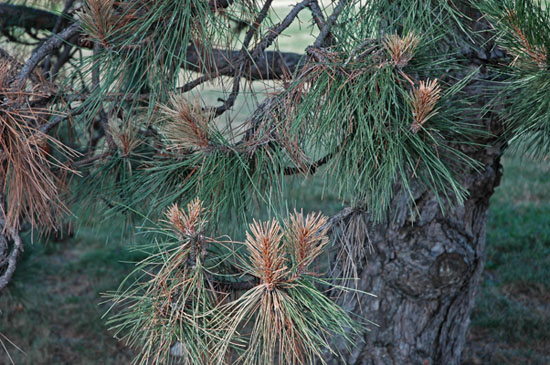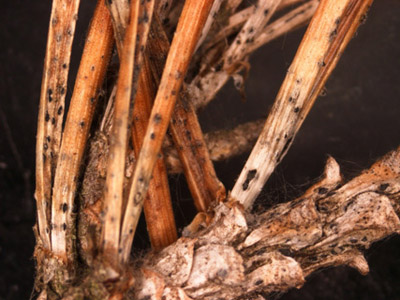Issue 11, July 2, 2010
Diplodia Blight Vs Pine Wilt and Dothistroma Blight
We have seen quite a bit of Diplodia blight on pines lately through the clinic. Many Plant Clinic clients ask for help in distinguishing this disease from pine wilt or Dothistroma blight. All three diseases will cause needles to turn brown. The pattern of symptoms will help with diagnosis in each case, as will the presence of fruiting bodies in the needles.
Diplodia tip blight causes entire needles to turn brown, not just tips of needles as might occur with Dothistroma blight, scorch, salt injury, or transplant shock. Diplodia blight causes all of the needles at the tip of a branch to turn brown as seen in the first image. A more definitive diagnosis can be made when fruiting bodies are found embedded in these brown needles. A fruiting body is a structure holding spores of a fungus. The fruiting bodies of Diplodia are pin-head sized, black, and embedded in the needles as seen in the second image. They are often most prevalent at the base of needles. If fruiting bodies are not visible, place the needles in a plastic bag with some moist (not dripping wet) paper toweling; blow some air into the bag; and seal with a twist tie. After 24 hours, again look for the fruiting bodies on the needles. They are large and difficult to miss on moist needles. With recent rains the fruiting bodies should be visible, even without incubation (plastic bag technique). If you do not see the fruiting bodies, Diplodia is not part of the problem. In the lab we like to take things one step further. We rarely make a disease diagnosis without seeing the spores of the pathogen causing the disease. We use a razor blade to remove a few of these fruiting bodies, then place them on a microscope slide, add a cover slip, and observe them with a compound microscope. When Diplodia is present, we see the spores flowing out of the fruiting bodies.


Pine Wilt, caused by the pinewood nematode (see issue #10, 2010), causes browning of needles too, but entire branches or entire sections of the tree are affected. Occasionally the whole tree turns brown at once. You will not see green needles at the tips of branches that are infested with pinewood nematodes.
If you look at a declining pine from a distance and see brown two- and three-year-old needles with green current growth, Dothistroma needle blight (see issue #3, 2009) is a strong possibility. Often Dothistroma blight causes the lower needles in the tree to exhibit bands of brown or yellow tissue. Often the tissue beyond those bands dries out, resulting in death of the needle tips on affected needles. The overall appearance is browning of the lower third to half of the tree. Early defoliation may occur in spring and summer. You might confuse these symptoms with salt burn or scorch which cause needle tips to turn brown on the exposed side of the tree.
Correct diagnosis of these diseases may save time and money in management practices. For further help, consult the following University of Illinois reports on plant diseases:
Diplodia Blight
Pine Wilt
Needle Blights of Pine
--Nancy Pataky
Author:
Nancy Pataky